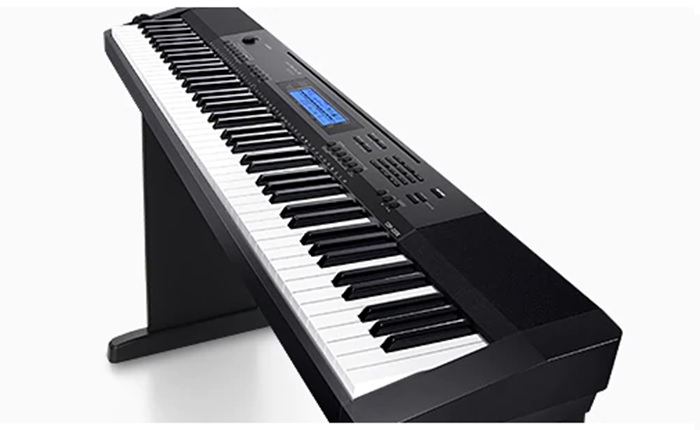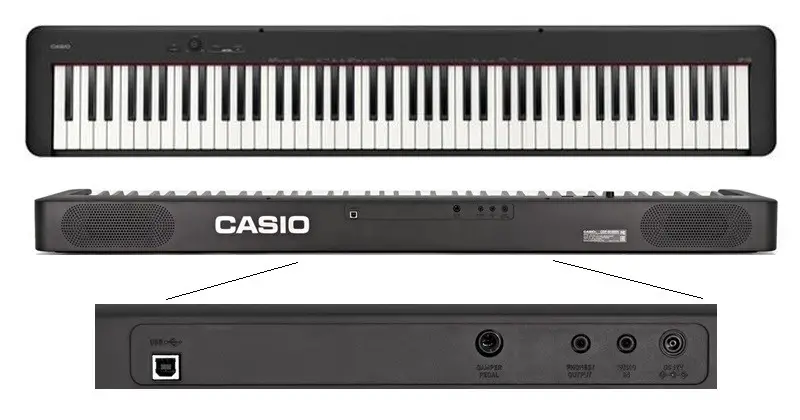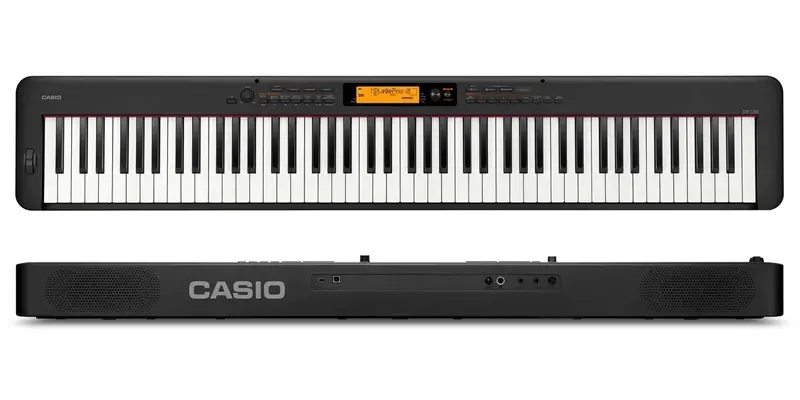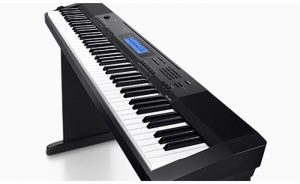
Casio’s CDP series includes affordable entry pianos, perfect for augmenting piano practice or for learning the piano. These digital pianos are easy-to-use, come with fully weighted keys and you get a limited set of decent warm-sounding tones. The new CDP-S models come in a slim, lightweight design. Skip to the best CDP series piano on Amazon
Introduction
Casio’s Privia range of pianos is already quite popular, but somewhere Casio felt the need for introducing more affordable digital pianos, with contemporary styling and features.
That’s why Casio introduced the CDP series (short for Contemporary digital pianos).
Casio’s CDP pianos have compact design, are lightweight, deliver realistic piano sounds, feature scaled hammer-action keys, USB MIDI, and come with built-in speakers. These come with a wide variety of Tones and Rhythms (only in select models).
- Pros: Entry-level digital pianos with good keyboard action, Inexpensive,
- Cons: Limited features
Casio CDP series includes “entry-level” portable digital pianos for beginners, and some of these pianos will also appeal to those who are looking for good quality, “ultra-compact”, digital piano.
The earlier CDP series models have made way to the news CDP-S models that feature a slim body (S stands for slim).
The new CDP-S series includes lightweight keyboards with scaled hammer action keys and built-in speakers but packed in a slim & stylish body. The CDP-S series are portable and can be operated using batteries.
Comparison Chart
- CDP-S350: Polyphony 64, 700 built-in tones, Scaled Hammer Action Keyboard
- CDP-S150: Polyphony 64, 10 built-in tones, Scaled Hammer Action Keyboard
- CDP-S240: Polyphony 64, 700 Tones, 200 Rhythms, Scaled Hammer Action Keyboard
Best Casio CDP Series Pianos
There are not a lot of options available in this series, just a couple of them. You can use these digital pianos for learning, practicing, performing, or just enjoying at home. Features a compact, slim design with weighted keys.
Casio CDP-240
Looking for a new a new full-size digital piano with several tones, songs and rhythms onboard? The Casio CDP-240 is a good option.
Casio CDP-240 is 88 Note piano with Weighted, Scaled Hammer Action.
You can also adjust the level of touch-sensitivity (Touch Response : 3 sensitivity levels). The Polyphony is 64 notes, which is decent for an entry-level piano.
You can use the 6-track recorder to create your own music to to help you with your music practice. The Step-Up Lesson system helps you to learn to play the built-in songs. The piano also has a small color screen that shows the various selections made.
700 Tones and 152 Built-In Songs, 200 Auto-Accompaniment Rhythms, 64 Note Polyphony.
You can buy a separate CS-44 Stand.
You may opt for the bundled package that comes with useful accessories. .
Looking for more features, you may consider the Casio PX-160 Privia piano instead.
More CDP Pianos
CDP-S100
Basic piano with 10 preset sounds. Scaled Hammer Action II Keyboard with simulated ebony and ivory textured finish.Read more.

Ensemble piano, wide range of tones and rhythms, pitch-bend controller, and more. Read more.

Chordana Play Piano App
CDP pianos are compatible with Casio’s free Chordana Play Piano App for IOS and Android devices. You need a cable connection between the piano and iPad/Tablet.
- Chordana software provides video lessons, and helps you learn famous classical music pieces.
- Chordana also works as a piano remote control and as a PDF music viewer.
Competition Check
There are few alternatives available to you, if you’re looking for a piano in this category. More pianos available in this price range:
- Alesis Recital Pro: Nice option from Alesis
- Yamaha P-71 Piano: Entry level piano from the P series
- Yamaha P-125: Better sounds and action
- Casio PX-160: Entry level piano from Privia series
- Yamaha DGX-660: Top model in the DGX series, great sounds and touch
Casio CDP: Buying Guide
Casio CDP contemporary digital pianos: Casio Privia Pianos have been doing extremely well ever since they have been launched in the market, but somewhere down the line Casio felt that there was a demand for slightly cheaper / lower spec’d digital pianos. The CDP range of pianos caters to that market segment.
Casio CDP vs Casio PX (Privia) Series: Differences
Casio CDP vs Casio PX (Privia) digital piano series: Here are the differences between the two series of pianos.
So if you’re a beginner who has been playing on keyboards for a long tie, and wish to graduate to an 88-key digital piano, you have the option of choosing from a Casio CDP or a Casio Privia piano, and if you’re looking for something cheaper the CDP is most likely to fit the bill.
Here are some more differences between the Casio CDP and the Casio Privia pianos:
The Casio CDP range stands for “Cabinet/contemporary Digital Piano”, which Casio promotes as entry-level contemporary pianos. The Casio PX range includes the “Privia” pianos, which are more expensive.
While the Privia includes higher spec’d pianos (with richer sounds), a complete beginner my find the CDP range to be more suitable. The CDP series includes lower spec, affordable entry models, designed for newer players.
If you’re fine with a limited number of sounds, but want weighted keys, the CDP is a good choice.
If you want a feature rich piano, with more sounds, styles and effects, the Privia would be a better choice.
KeytarHQ editorial team includes musicians who write and review products for pianists, keyboardists, guitarists & other musicians. KeytarHQ is the best online resource for information on keyboards, pianos, synths, keytars, guitars and music gear for musicians of all abilities, ages and interests.




I bought the CDP-135 as my first piano, used to play on a keyboard earlier. I selected the CDP-135 after comparing it with other digital pianos in the price range. The keys are graded hammer-weighted, the piano sounds are good, I like USB MIDI feature as I like to use computer software to learn and even to create music. I had checked the Yamaha P-45 as well but this one was cheaper by almost 50 bucks.